A raisin is a dried fruit made by drying grapes. There are many types of raisins in the world made from various grape cultivars, but the more commercially known raisins are made from a handful of grape varieties. These include Thompson seedless, Flame seedless, Sultana, Muscat, and black Corinth. The grapes’ diversity and discrete drying methods create divergence among the resulting raisins in terms of shapes, colors, sizes, and flavors.
Raisins can also be black, red, golden, or green.
The drying process varies with each raisin type in each country. The only thing that never changes much is the chewy texture and sweet (or sweet and tart) flavor.
This article explores the more common types of raisins, how they are made, and how they can make a difference to the end consumer, YOU!
Keep reading.
6 Types of raisins That You May Not Know
There are generally six known types of raisins that we have classified here.
- Regular or Black raisins
- Golden raisins
- Sultanas
- Currants
- Red raisins
- Green raisins
You may hear other names in other references, but they generally belong to any one of these groups. You may also find some of the descriptions slightly in contrast to your expectations. As mentioned before, the disparity might result from the type of grape used and the processing methods.
Black Raisins: Found Everywhere
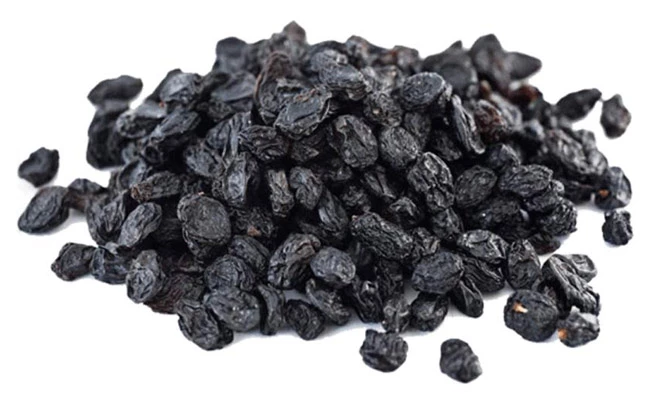
Regular Raisins are the most common type of dried grape. It is usually made from seedless Thompson grapes laid on paper and sun-dried for three weeks but can be made from grapes with any skin color. The raisins turn brown to black as they dry (Figure 1).
Different types of black raisins include Jumbo, small, and midget.
The browning reaction has a direct relationship with heat and sunlight. The higher the heat and more direct the sunlight, the darker the raisin and more caramelized the flavor.
Regular raisins are sweet with a sticky consistency. They can sometimes be soggy (wet and soft) from the inside. But they can also have a gritty texture if overdried.
Regular raisins can be chewed on as a healthy afternoon snack. They can also be used as a cooking or baking ingredient.
Regular raisins can soak up other flavors when mixed with other food ingredients. For example, they can make a gourmet addition to a cheese platter.
Golden Raisins: A Rey of Sunshine
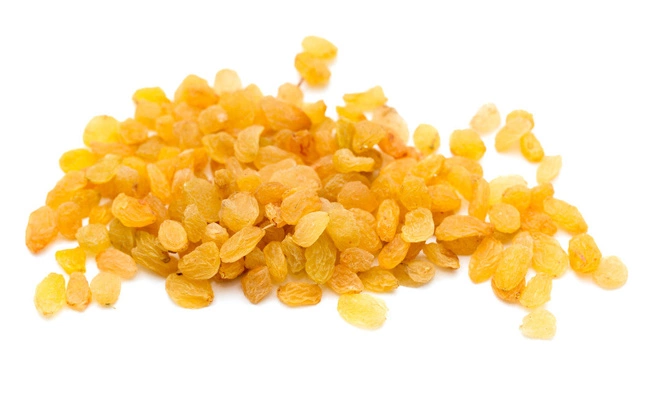
Like regular raisins, Golden Raisins are obtained from seedless Thompson or Golden seedless grapes but are dried in a dehydrator or dryer at controlled temperatures and humidity levels. Drying in a dehydrator also avoids the darkening impact of sunlight.
Golden raisins are also treated with sulfur dioxide gas as a color stabilizer and preservative. Sulfur dioxide has always been known for its health benefits. It creates a fruitier, lighter flavor in golden raisins.
Golden raisins taste great in a trail mix with nuts (peanuts, cashews, and pistachios). Iranian use them in New Years’ Mix to give their relatives and friends joy.
Green Raisins: Sweet Heart in Tangy Clothes
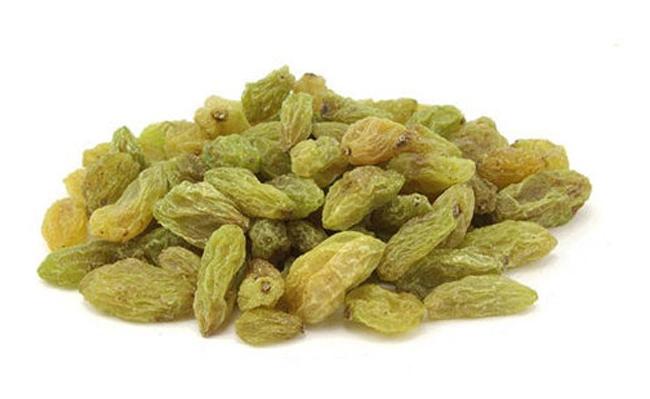
Green Raisins are slim, 2 to 3 cm long raisins from the Middle East and Central Asia. Green raisins are made from green grapes and are slightly dense and chewy with a slight tartness like fresh ones.
In most cases, making green raisins involves shade-drying the grapes in well-aired but dark indoor conditions. The condition helps retain their pale jade hue. Sometimes, sulfur dioxide or other acid is used to stabilize the color.
Green raisins are sweet (slightly tangy) and can add natural sweetness to savory dishes. They two can soak up flavors from other ingredients.
Flame Raisins: Irony Sweet
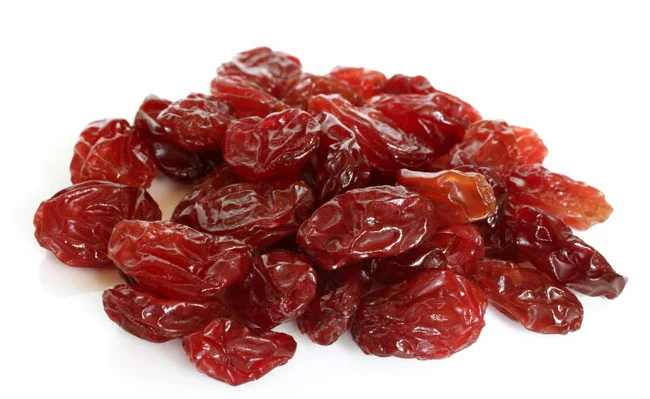
Flame Raisins (also known as Red Raisins) are made from red-skinned, seedless, flame grapes. It is well-known for its large size, similar to regular raisins, except red.
Red or flame raisin is exceptionally sweet, firm, and high in iron and dietary fiber, making it an excellent snacking choice.
Producing red raisins involves washing the grapes and drying them naturally in the sun to create a rich taste in them.
Flame raisins are excellent for baking cookies, muffins, and bread.
Sultanas: No Confusing at All
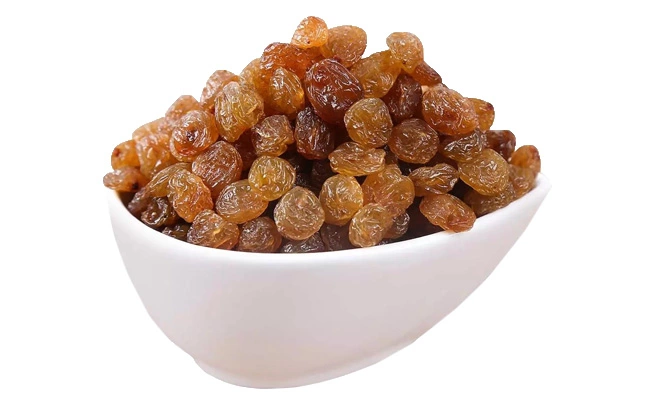
Among all types of raisins, sultana is more confusing and less understood. Here we explore the matter.
Sultana is a name given to a grape variety historically used to produce “round kishmish” in ancient Persia. The grape berries are round, light green to amber yellow, and more transparent than ‘Thompson Seedless.’ It produces a less meaty and more reddish-colored raisin.
The Sultana grape was introduced to the US in the 1800s, and it should not be confused with sultana raisin (also called sultania) made from Thompson seedless grape.
Thompson Seedless’ was also originated in ancient Persia, in an area that now comprises parts of Iran and Turkey. The variety was first introduced to California in 1872 by William Thompson of Yuba City, so it became known as the Thompson grape.
Thompson Seedless is currently the most cultivated grape variety grown throughout the world. The color variation in raisins is because manufacturers use different drying techniques and pretreatments.
Sultana raisins in Iran are those sweet, light brown, large raisins (see picture) made from Thompson seedless grapes treated with a drying solution that accelerates the drying and helps stabilize the color.
If you are from Australia or the UK reading this post, you would know that sultana refers to “natural sultana,” which are sundried Thompson seedless grapes without receiving any drying solution.
In the US, people sometimes use sultana to refer to golden raisins, which are Thompson seedless grapes dried in a dehydrator after being treated with a drying solution.
Adding Sultanas to muffins, granola bars, and cookies is a great way to sweeten baked goods. They can perfectly soak up other flavors, making the finished product even tastier.
Currants: The Little Brothers
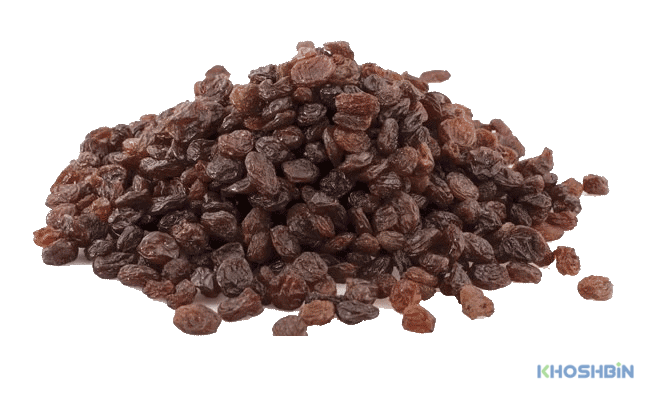
Currants or Black Corinth are dried grapes of the same name. [Do not mistake Black Corinth for Black Currant, which is a berry, not a grape]. The word “currant” refers to the size of the raisin, which is small (under 1cm across), and the term black Corinth is used to differentiate these grapes from white Corinth and Red Corinth, which are not actual grapes with a much more sour flavor.
Black Corinth or Carina was initially traded out of the Corinth port in Greece, from which it got its title. Black Corinth or currants are alternatively known as Zante Currants.
Currants are typically made by sun-drying the grapes for up to three weeks. They have a sweet, tangy, and intense flavor and can soak up the liquid in the mixture. You can add currants to both sweet and savory dishes to give texture and sweetness to them.
Read More : how to use date syrup
Conclusion
The list of different types of raisins is longer than we can include in this little space. We limited the discussion to popular types of raisins and their uses, excluding the less common ones because of their declining popularity (such as Muscat).
Identification differs depending on where you live and the processing method. Still, all raisins belong to any one of these raisin groups: Regular Raisins, Golden Raisins, Green Raisins, Red Raisins, Sultanas, and Currants.Raisins are made from Thompson seedless, Flame, or black Corinth. More raisins are made from Thompson seedless grapes than any other type.
Now, how do you name raisins in your country? Which type of raisin is more common where you live? Can you tell us how you dry them?
Please write your comments in the comment section below.
FAQ


Dear,
Good day.
Hello, I am [..]] from Malaysia and work in the sourcing department at Syarikat Thong Guan Trading Sdn. Bhd. Our company produces and trades beverages and flexible packaging for industrial and commercial use. For more details about our company, please visit our website at […]. We also directly import some materials and finished goods for repackaging and direct sales in the Malaysian market..
Here we are looking for materials for organic raisin products, and found that your company’s website provides raisin, and we are interested in raisin. But I don’t know whether your products are organic or non-organic? If it is organic products, please give us a quotation for the CIF price of the following materials per ton in USD, the currency used by the port of Penang, Malaysia:-
1) Product Name : Organic Sultana Raisin
– Scientific name :
– HS code ( 10 digit, at least 6 digit ) :
– Packaging Detail ( Bulk Bag ) :
– Country of origin :
– Harvest crops :
– CIF price :
These products must have an organic certificate and a Halal certificate. Could you please provide us with the certificates for verification? If a Halal certificate is not available, please provide us with the product flow chart and product specifications for us to check and verify first. We hope to receive your reply email as soon as possible.
We hope will receive your reply email ASAP.
If you have any doubts, please feel free to contact me via WhatsApp or email.
Thanks.
Best Regard,
Lin
[…]
I need plump dried muscat raisins in bunches/stalks.
Contact me by email for more information. Thank you
Currants are not grapes so you can’t call them raisins. Currants are genus Ribes and are related to gooseberries. Raisins are dried grapes of the genus Vitis. Not the same fruit.
Currants are raisins or dried grapes. The blackcurrant (Ribes nigrum), also known as black currant or cassis, is a shrub in the family Grossulariaceae producing edible berries.
that doesn’t really matter they’re all just dried fruit and they all look like grapes anyways. I bet you like the black raisins and the currants the most.. ://
Hey, you are taking this too seriously. They are all grapes so it doesn’t matter. Currants are like grapes and no one makes raisins from gooseberries. I bet you are a black raisin or currant lover..
Hi, i need to purchase 10,000 kg of Raisins for my food store. Please call or whatsApp: +971 55 831 7007, Muhammed Shanid
This article is only to inform people about Raisins. Look for raisins at the grocery store or call manufactures.
Very informative article, thank you. I thoroughly enjoyed it and am a lot wiser now than I was about dried fruit. Just one question, what does Rey mean? The only translation I can find is ‘king’.
I think it’s a typo – supposed to be “rAy” (IMO)
Freeze dried grapes is much superior option to raisins I believe. I have made some samples. Is there any industry manufacturing these commercially? Is anybody interested? We can contract manufacture.
I am interested would like to speak with you.
9881782328
sanketanna@gmail.com